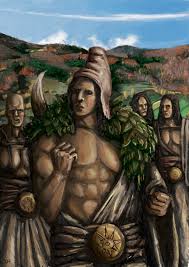Easter: A Vedic festival
Easter is a Babylonian abomination that has made its way into the Christian mainstream. The name actually comes from Ishtar, the Goddess of fertility in Assyria.
However, this is simply the Babylonian Astarte. Being the Goddess of fertility, it was only natural that the favorite symbol of fertility be used in the spring festival that we now call Easter, that being the egg.
 |
| Astarte |
Pastors who celebrate this are in grave violation of the Commands of Christ when they conduct the passion of Christ during this time. The Scriptures are very clear when Jesus was crucified it was on Passover. We know exactly when Passover is and we know that is when Jesus was crucified. Why does the mainstream 'Church' continue in the pagan abomination?
In the gospel tale, there are two dates for the crucifixion: the 14th and the 15th of the month of Nisan, and within Christianity the date for Easter was debated for centuries. There continue to be two dates for Easter: the Western Catholic and Eastern Orthodox, thus demonstrating that this holiday is not the historical date of the actual crucifixion of a particular man. The dates are, in fact, astronomical, astrological and astrotheological.
Rather than being a "Christian" holiday, Easter celebrations date back into remotest antiquity and are found around the world, as the blossoming of spring did not escape the notice of the ancients, who revered this life-renewing time of the year, when winter had passed and the sun was "born again." The "Pagan" Easter had been celebrated before the time of Jesus, every year by a number of cultures, including the Egyptians, possibly as early as 4,000 years ago and continuing to this day in some places.
The Phrygian sun and fertility god Attis was annually hung on a tree, dying and rising , an "Easter celebration" that occurred at Rome as well.
According to the Phrygian tale, Attis was a beautiful youth born of Nana, the daughter of the river Sangarius, and the hermaphroditic Agdistis. Having become enamoured of Attis, Agdistis struck him with frenzy as he was about to be married, with the result that Attis castrated himself and died. Agdistis in repentance prevailed upon Zeus to grant that the body of the youth should never decay or waste. Other versions also exist, but they all retain the essential etiological feature, the self-castration.
Attis was fundamentally a vegetation god, and in his self-mutilation, death, and resurrection he represents the fruits of the earth, which die in winter only to rise again in the spring.
Persephone and Hades ( Greek)
The springtime/Easter resurrection myth occurred in Greek mythology with the tale of Kore/Persephone descending into the underworld to reside with Hades, leading to the death of winter. Her remergence out of the underworld represented the springtime renewal of life on Earth - thus, Persephone's resurrection symbolized eternal life.
The word is “Eostre” in the Old English, and it has to do with “east,” but it appears also to be related to the Greek word “Eos,” which refers to the dawn and was deified as the dawn goddess:
This word Eos, Eostre, Ostara, is related to Sanskrit and Vedic usra or ushas, the Zendic ushastara and the Lithuanian Ausra, the old Teutonic austron, and the male spring or dawn deity…In the long run, while the words “Ishtar” and “Easter” may not be related, the celebration of “Easter” is assuredly a pre-Christian vernal equinox and fertility festival.
"In the polytheistic pantheons of antiquity there usually was a king or chief of the gods, and also a female counterpart who was regarded as his wife. This mother goddess was one of the most important deities in the ancient Near East. She was called by the various names of Ishtar, Athtar [sic], Astarte, Ashtoreth, Antit, and Anat. This mother goddess always was associated with human fertility. In the course of time Mary was to become identified with this ancient mother goddess, or perhaps it should be said that Mary was about to supplant her in certain Christian circles." (Wolfe, 234)
These facts show how christian missionaries were fooling the whole world for years. The missionary first of all studies a vedic religion and it's followers that they wish to convert and then try to find similarities or add some made stories into that of Jesus's life to make the vedic followers impressed. ( Fake Stories like virgin born from Egyptian Horus ) and then go out of conversion. They promise salvation, peace and equality, then consume the religion. They renamed Pagan Winter Festivals Christmas and Fertility Festival as Easter.











Comments
Post a Comment